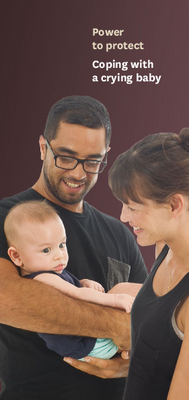Power to Protect: Coping with a crying baby - HE2460

This resource for health professionals to use with parents and caregivers talks about the reasons why a baby may cry, gives tips for how to cope, and explains the damage that can be caused by shaking a baby. Printed copies of this pamphlet are limited and restricted to 200 copies per order (by health professionals). However, everyone can read the information online and download a PDF copy. Much of the information in this pamphlet is also contained in the Well Child Tamariki Ora My Health Book so parents should be referred to their copy in the first instance.
The full resource:
Caring for a baby can be challenging at times. Although you will have lots of great moments, you may also have some worries about what is best for your baby. One of the hardest times can be when baby cries, and you can’t work out why. This can be very frustrating.
Why babies cry
Crying is how babies communicate. Sometimes they are telling you something is wrong. Sometimes they just want and need your attention and love. Crying does not mean your baby is naughty.
Often, you won’t be able to find a reason for your baby crying. This can be very frustrating.
If your baby won’t stop crying, have a look at the helpful checklist below for tips on crying.
Never, ever shake a baby
The number one reason why babies are shaken is because their caregivers become angry or frustrated.
Shaking a baby can cause:
- permanent brain damage
- paralysis
- blindness
- deafness
- seizures
- broken bones
- developmental delay
- death.
You have the power to protect. When your baby won’t stop crying, be strong enough to walk away, take a break and come back ready to comfort your baby.
“After a few minutes away, I feel 100% better. I am calmer and happy to comfort her.” Father of three month old baby
Getting help
Friends and family members
Your midwife, GP or well child provider
If you’d like someone to talk to, call:
Plunketline 0800 933 922
Lifeline 0800 543 354
Youthline for young parents 0800 376 633
Youthline Free TXT 243
If you have family worries and would like someone to talk to, you can call an Oranga Tamariki social worker on 0508 FAMILY (0508 326 459).
Why not take some time now to list the names and numbers of close friends and relatives you can call.
If you think your baby has been shaken, get help straight away. Don’t let fear or pride stop you. It could save your baby’s life.
Phone 111 for urgent medical help.
Crying checklist
- Cuddle your baby
- Try offering a feed again
- Change the nappy if it is wet or dirty
- Make sure your baby’s clothing is not too tight
- Make sure your baby isn’t too hot or cold
- Burp your baby (wind pain can be very uncomfortable)
- Wrap and hold baby safely in a lightweight blanket
- Is baby tired? Put baby down somewhere safe to sleep.
I’ve done all this and baby’s still crying… now what?
- Hold your baby close, massage their back, sing, hum or talk
- Give baby a warm soothing bath or take one together. Never leave baby unattended in the bath
- Put baby in a stroller and go for a walk or in a car seat for a short drive.
If you are worried baby is unwell, contact your midwife, GP or well child provider.
Never leave your baby alone with someone you think might lose control.
Keeping your baby safe
Have a plan of what you will do if your baby keeps crying and you become upset or angry.
If you think you might lose control, do not pick up baby!
Walk away
If you’re holding baby, put baby in a safe place and walk away. Leave the room.
Take a break
Check baby often, but do not pick baby up until you feel calm.
Try doing something that usually relaxes you, like a quick shower or a cup of tea.
Talk to someone
Call a relative, friend or trusted neighbour to give you a break.
Don’t be embarrassed. It’s OK to know when you’ve reached your limit.
For more advice or help, visit www.kidshealth.org.nz/crying-what-do
Code: HE2460